Note: Your are not logged in. We can not keep your scores or track your progress unless you Register and Log In
Driver's Handbook on Cargo Securement - Chapter 4: Dressed Lumber and Similar Building Materials
What Does This Section Cover?
The requirements for dressed lumber and similar building materials section apply to certain products when they are transported as bundles on flatbed and open vehicles.
These products are:
- Dressed lumber.
- Packaged lumber.
- Engineered building products (e.g. plywood, drywall, other materials of similar shape).
Note: Lumber or building products that are not bundled or packaged should be treated as loose items and transported in accordance with the general cargo securement requirements in Section 2.
Bundles carried in a closed vehicle should be immobilized or contained in accordance with the general cargo securement requirements in Section 2.
Positioning and Securing Bundles
Requirements for bundles placed side by side on a platform vehicle

Choose one of two options for positioning bundles:
-
Option #1:
Place bundles in direct contact with each other.
-
Option #2:
Provide a means (such as dunnage or blocking) to prevent the bundles from shifting towards each other.
Requirements for bundles in one tier
Secure bundles in accordance with general cargo securement requirements
Web tie-downs are often used to secure building materials.
Requirements for Securement System:
- In proper working order with no damaged or weakened components that affect their performance or reduce their working load limit.
- No knots.
- Attached and secured in a manner that prevents them from coming loose during transit.
- Able to be tightened by a driver of an in-transit vehicle.
- Located inboard of rub rails whenever practicable.
- Edge protection must be used when a tie down would be subject to abrasion or cutting.
Multiple-Choice Questions:
Which of these are requirements for securement systems?
- These all qualify as requirements.
- There should be no knots in the tiedowns.
- Components should be in proper working order.
- If a tiedown would be subject to cutting or abrasion, edge protection should be used.
Requirements for Securement System:
- In proper working order with no damaged or weakened components that affect their performance or reduce their working load limit.
- No knots.
- Attached and secured in a manner that prevents them from coming loose during transit.
- Able to be tightened by a driver of an in-transit vehicle.
- Located inboard of rub rails whenever practicable.
- Edge protection must be used when a tiedown would be subject to abrasion or cutting.
One option of positioning bundles of building materials is:
- Lean them to the outside.
- Place them in direct contact with each other.
- Lean them against each other.
- Turn them so only their corners are touching.
Choose one of two options for positioning bundles:
-
Option #1:
Place bundles in direct contact with each other.
-
Option #2:
Provide a means (such as dunnage or blocking) to prevent the bundles from shifting towards each other.
When securing building materials, how many knots are acceptable in the tiedown(s)?
- 1
- 2
- 0
- Depends on the weight of the cargo.
Requirements for Securement System:
- In proper working order with no damaged or weakened components that affect their performance or reduce their working load limit.
- No knots.
- Attached and secured in a manner that prevents them from coming loose during transit.
- Able to be tightened by a driver of an in-transit vehicle.
- Located inboard of rub rails whenever practicable.
- Edge protection must be used when a tiedown would be subject to abrasion or cutting.
Complete!
You can Return To The Table Of Contents







 TT On Facebook
TT On Facebook